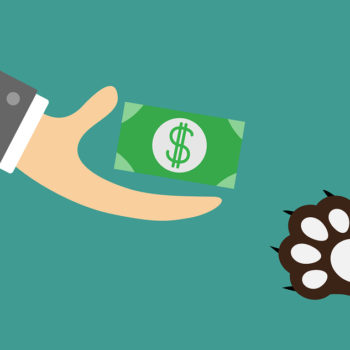Pretend you don’t work for your animal organization, but just heard about it on Facebook. Maybe you read that there was an urgent need for funds to repair damage from a fire, or to buy a new spay/neuter van, or pay the veterinary expenses of an injured pet. Whatever the reason, click over to your website as if you’d never been there before, and try to donate.
In fact, if you can, actually donate. Go through the process from start to finish. Then take a look at these four tips, and see if your organization is missing any of them.
1. The easy-to-locate donate button and/or page
Some nonprofits make the mistake of burying their “donate” link in a navigation menu.
Giving will be increased if there’s a big, highly visible button that says “Donate” in the upper right hand side of all of your pages. No one should have to click on anything, or scroll, to see it. And since the upper right-hand corner of a website is where most people’s eyes naturally search for things, that’s where you should put your “Donate” button.
And by the way, it should really say “donate,” not “support us” or “how to help” or anything else. It’s valuable to have other ways people can help you — an Amazon wishlist, volunteering, fostering, and anything else you might need — but that’s not what the donation button is for. It’s fine, however, to ask for those things on your donation page.
Yes, we said “donation page.” Many “Donate” buttons go directly to PayPal or some other third-party site that handles donations for you. While some third party donation services provide a page look and feel exactly like your site and can offer a great deal of functionality, many groups simply direct their donate button traffic to PayPal and other free or stripped-down services. This practice is less than optimal for many reasons, including:
- You lose a valuable opportunity to present your case to your donors, and ask for what you want them to do. You want to tell them what you need and what you’ve done with past donations. You can’t do that on PayPal, and your ability to do so is difficult to non-existent on most third-party giving pages.
- You also lose your chance to tell them all the other ways they can help the animals in your organization’s care. This may be a wonderful opportunity to engage them with your group, at a time when you’re asking them for support.
- Customized donations — memorial giving, in-honor-of donations, monthly vs. one time support, donations to a specific fund — are more difficult, or impossible, to implement on many third party sites.
- On-the-fly editing of the donation page, and creation of specific funds, may be limited. This can hold you back in an emergency situation.
- Without a donation page, people can’t share your donation page on social media. While baking share functionality into the giving process is ideal, it’s not always feasible. But making sure you have a page on your website that people can share to their social networks is easy and highly valuable.
2. Offer multiple ways to give
Some people hate PayPal. Others won’t give their credit card information. Still others only want to donate if they can snail mail you a check.
Do you have all the information people need, including to whom to make out a check, to donate? Do you offer options that include credit cards and PayPal, or even electronic checks or regular transfers from a financial institution?
This applies to non-cash donations, too. Some people prefer not to use Amazon wishlists, but may happily send you a Kurunda bed through their shelter donation program. Try to offer as many options as you can without overwhelming your team or the functionality and look of your donation page.
3. Be mobile-compatible
Every year, the percentage of online giving that’s done via mobile device goes up. Of those people who learn about your need or your mission through social media, where more than 50 percent of all users are on mobile devices, that’s even more of an issue.
While your whole website should be mobile-compatible, this is an urgent need for your donation page.
4. Embed a “thank you” that’s also an opportunity for increased engagement
Every giving platform is a little different in how it works, but generating an acknowledgement and thank you email to your donors is not optional. If the system you’re using is not automated, you’re going to waste valuable time making people feel their donation was appreciated or even received.
After the automatic thank you letter goes out, definitely follow up with something more personal. But don’t lose that immediate opportunity to express your gratitude. And don’t miss the chance to ask your new donor to follow you on social media, and to tell them a little bit about what you’ll be doing with their contribution.
The moment of giving is emotionally rich for most people, and that’s the best time to tie their good feeling to your good works!

